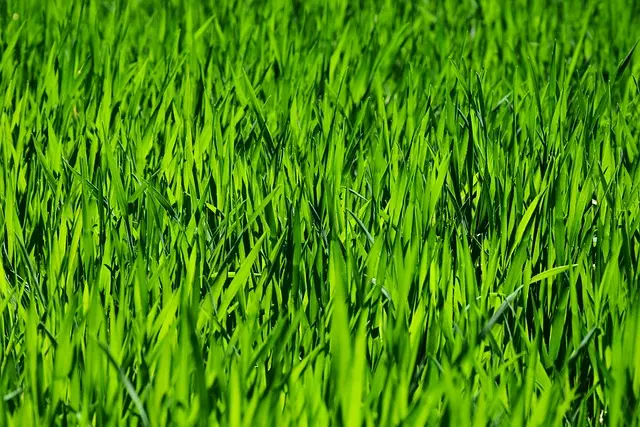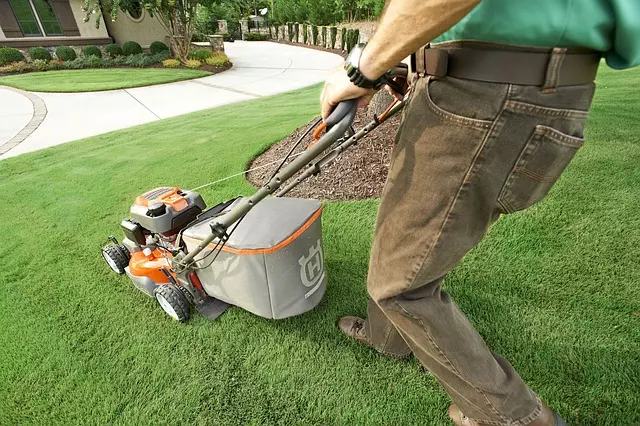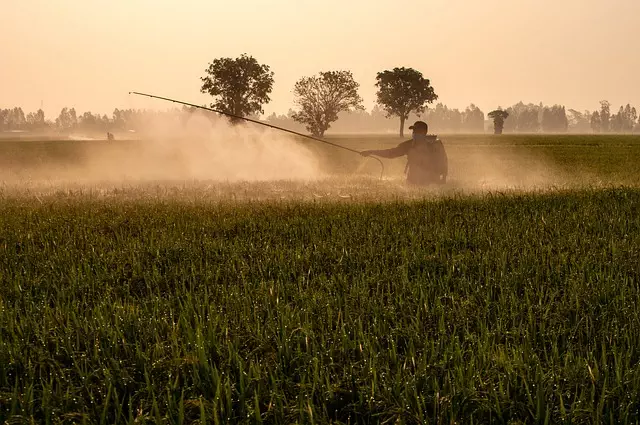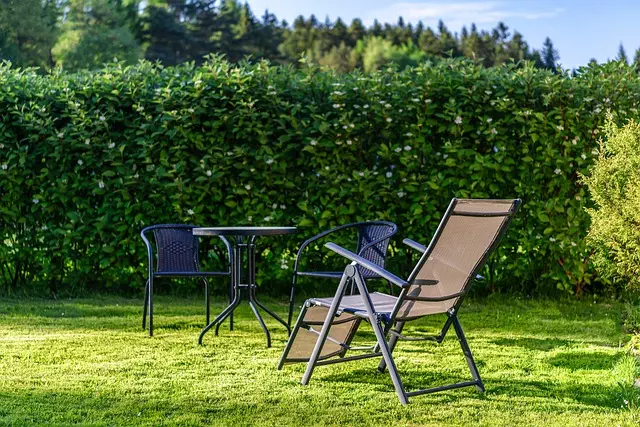Effective lawn care and landscaping encompass mulching and edging practices that are crucial for a healthy and vibrant lawn. Mulching helps to conserve soil moisture, suppress weeds, and enrich the soil with organic matter, leading to a more robust root system and a denser, lusher lawn. It also aids in sustainability by reducing water usage. Edging serves to sharply define the lawn's boundaries, which not only enhances aesthetic appeal but also facilitates precise maintenance and prevents turf encroachment into unwanted areas. Regular edging, approximately every two weeks during active growth, is essential for maintaining clean and defined borders, particularly when following a routine that includes mulching. For optimal results, these tasks should be performed after mowing, with consideration for soil type and plant species' needs to ensure the best outcomes. By integrating these practices into your lawn care and landscaping regimen, you can transform your outdoor space into an attractive and well-maintained area that reflects careful garden management and a commitment to sustainability in lawn care.
Effective lawn care and landscaping hinge on practices that promote both health and aesthetics. This article delves into the transformative impact of mulching and edging on lawn maintenance, offering insights into how these techniques can elevate your turf’s appearance while ensuring robust growth. Discover the intricacies of strategic mulching in enhancing soil quality and retarding weed proliferation, alongside precision edging techniques that provide clear-cut, refined lawn borders. Furthermore, learn how integrating mulch and edging into a cohesive approach can significantly bolster your lawn’s visual appeal and functionality, all within the realm of lawn care and landscaping.
- Optimizing Lawn Health: The Role of Strategic Mulching in Lawn Care and Landscaping
- Precision Edging Techniques for Defined Lawn Borders in Lawn Care and Landscaping
- Integrating Mulch and Edging: A Comprehensive Approach to Enhancing Lawn Aesthetics and Functionality in Lawn Care and Landscaping
Optimizing Lawn Health: The Role of Strategic Mulching in Lawn Care and Landscaping

Mulching plays a pivotal role in the maintenance and enhancement of lawn health, representing an integral component within comprehensive lawn care and landscaping practices. Strategic mulching not only conserves soil moisture but also moderates soil temperature, providing an optimal environment for grass growth. By applying a thick layer of organic mulch around the base of the turf, lawns benefit from the gradual breakdown of organic matter which enriches the soil with essential nutrients. This process supports the health of the grass by fostering a denser and more resilient root system, ultimately leading to a lusher, more vibrant lawn. Additionally, mulching helps to suppress weeds and reduce the need for frequent watering, making it an environmentally friendly approach that contributes to long-term lawn care and landscaping sustainability.
Edging, in tandem with mulching, is another essential practice in maintaining well-defined boundaries between turf and garden beds or hardscape areas. A sharp edge not only aesthetically delineates the lawn from surrounding elements but also promotes healthier grass by preventing the encroachment of weeds and other unwanted vegetation. This clear demarcation ensures that lawn care and landscaping efforts are focused and effective, creating a cohesive and manicured appearance. Regular edging, when performed as part of a routine lawn maintenance schedule, complements the benefits of mulching by enhancing the overall presentation and health of the landscape. Together, these practices form a comprehensive approach to lawn care and landscaping that can significantly improve the visual appeal and longevity of any lawn.
Precision Edging Techniques for Defined Lawn Borders in Lawn Care and Landscaping

In the realm of lawn care and landscaping, precision edging techniques play a pivotal role in defining clear and aesthetically pleasing borders for your lawn. A well-maintained edge not only enhances the visual appeal of your yard but also promotes healthy plant growth by preventing grass encroachment onto walkways or garden areas. To achieve clean and sharp edges, professionals recommend using a half-moon edger or a string trimmer with an edging attachment. The technique involves carefully following the existing border, such as a sidewalk or flowerbed, to remove a thin strip of grass and soil, creating a crisp demarcation between the lawn and adjoining areas. This process helps to prevent turf from overgrowing into these spaces, which can be both unsightly and detrimental to plant health. Regular edging, ideally every two weeks during active growth periods, ensures that your lawn’s borders remain neat and well-defined, contributing to a meticulously maintained landscape.
In addition to the physical tools used, the approach to edging also matters. A strategic edging routine should be part of your comprehensive lawn care and landscaping plan. It’s beneficial to edge after mowing when the grass is dry and not too tall. This reduces the risk of clogging your edging tool and ensures a cleaner cut. Additionally, consider the type of soil and plants in your border as this can influence the frequency and method of edging required. For instance, clay soils may require more gentle handling to avoid displacing soil and damaging plant roots. By integrating precision edging into your lawn care and landscaping regimen, you’ll enjoy a neatly trimmed lawn that serves as a canvas for the rest of your garden’s beauty, all year round.
Integrating Mulch and Edging: A Comprehensive Approach to Enhancing Lawn Aesthetics and Functionality in Lawn Care and Landscaping

Integrating mulch and edging plays a pivotal role in enhancing both the aesthetics and functionality of your lawn, which are key components of effective lawn care and landscaping practices. Mulching serves to retain soil moisture, suppress weeds, and improve soil quality over time. By applying a generous layer of organic mulch around plants and along garden beds, you create a protective barrier that conserves the soil’s natural warmth and nutrients while preventing weed encroachment. This not only promotes a healthier lawn but also contributes to the overall visual appeal by maintaining a uniform and well-groomed appearance.
Edging, on the other hand, delineates the boundaries between your lawn and garden beds, sidewalks, or driveways, providing clear, defined lines that enhance the structured look of your landscape design. A sharp edge not only prevents grass from overgrowing into undesired areas but also makes mowing easier and more efficient by offering a precise guide for the mower’s path. When combined with an effective mulching strategy, edging ensures that each area of your lawn is maintained separately, allowing for targeted care and fostering a lush, manicured green space. The combination of these practices under the umbrella of lawn care and landscaping can transform an ordinary yard into an extraordinary outdoor living space that is both pleasing to the eye and easy to maintain.
In conclusion, strategic mulching and precise edging serve as cornerstone practices within the realm of lawn care and landscaping. These techniques not only optimize lawn health but also create defined borders that enhance both the aesthetic appeal and functionality of your outdoor space. By integrating these approaches, homeowners can achieve a manicured look that requires less maintenance while fostering a healthier environment for their grass to thrive. Implementing these practices is an investment in the longevity and beauty of your lawn, contributing to the overall curb appeal and making your outdoor living space more enjoyable. With careful attention to detail in mulching and edging, your lawn will stand out as a testament to meticulous lawn care and landscaping.


